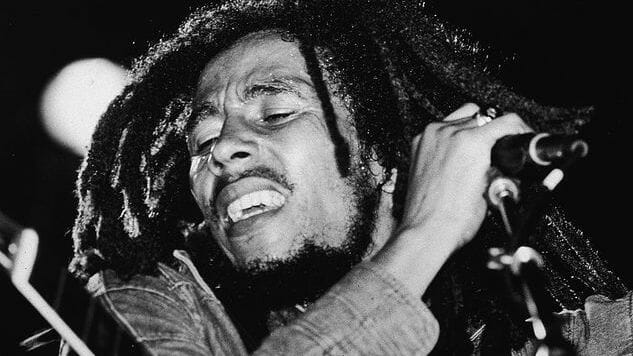Roger Steffens Weaves the Oral History of Bob Marley in So Much Things to Say
Photo of Bob Marley by Express Newspapers / Getty
We lead double lives. We think in abstractions like Love and Freedom and Nation, but we dwell in the world of physical specificity: this time, this place, this location. Michelangelo’s David sculpture, for example, floats weightless in the collective mind. How far are you, right now, from its image? Probably less than 20 feet, if you count looking it up on the Internet. But I have seen David, and it sits in a specific room in a specific building at a specific address. Music is just as much a hostage of a particular set of contingencies as the humblest sculpture. A musician is born in this place, her sound is associated with this studio, her music is understood in this context.
Oral history ties the general icon to the specificity of the world. It does this by taking the abstract giant, a creature of an agreed-upon narrative that everyone knows, and sourcing that figure to many voices speaking from multiple perspectives. It’s history from the grassroots, and the grass knows everything.
 Roger Steffens’ new book, So Much Things to Say, ties Bob Marley, the Jesus of Reggae, to the slums of Kingston, Jamaica. Steffens’ text reminds us of an icon’s embedded nature, enmeshed in tentacles of circumstance. In history, some figures stand out like tall trees. Popular wisdom usually has no explanation, except to say, “Isn’t it funny that happened?” But oral history shows the rootedness of such titans. If you know where one originated, you can trade belief in a single, miraculous figure for the certain knowledge that whatever conditions produced the miracle must have been miraculous as well.
Roger Steffens’ new book, So Much Things to Say, ties Bob Marley, the Jesus of Reggae, to the slums of Kingston, Jamaica. Steffens’ text reminds us of an icon’s embedded nature, enmeshed in tentacles of circumstance. In history, some figures stand out like tall trees. Popular wisdom usually has no explanation, except to say, “Isn’t it funny that happened?” But oral history shows the rootedness of such titans. If you know where one originated, you can trade belief in a single, miraculous figure for the certain knowledge that whatever conditions produced the miracle must have been miraculous as well.
-

-

-

-

-

-

-

-

-

-

-

-

-

-

-

-

-

-

-

-

-

-

-

-

-

-

-

-

-

-

-

-

-

-

-

-

-

-

-

-








































